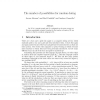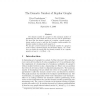131 search results - page 5 / 27 » Colouring Random Regular Graphs |
STOC
2003
ACM
14 years 8 months ago
2003
ACM
Random regular graphs play a central role in combinatorics and theoretical computer science. In this paper, we analyze a simple algorithm introduced by Steger and Wormald [10] and...
JCT
2008
13 years 7 months ago
2008
Let G be a regular graph and H a subgraph on the same vertex set. We give surprisingly compact formulas for the number of copies of H one expects to find in a random subgraph of G...
ARSCOM
2004
13 years 7 months ago
2004
The domatic number of a graph G is the maximum number of dominating sets into which the vertex set of G can be partitioned. We show that the domatic number of a random r-regular g...
STOC
2002
ACM
14 years 8 months ago
2002
ACM
We analyze a randomized version of the Brelaz heuristic on sparse random graphs. We prove that almost all graphs with average degree dp4:03; i.e., G?n; p ? d=n?; are 3-colorable a...
GLOBECOM
2007
IEEE
14 years 1 months ago
2007
IEEE
—In this paper, we clarify inter-link interference in wireless ad-hoc networks by using link-directional interference graphs (l-graph). Most of the interference graphs in the lit...


